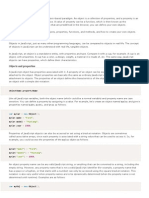A Comprehensive Guide to JavaScript Objects - Part 2
Uploaded by
xubairaccaA Comprehensive Guide to JavaScript Objects - Part 2
Uploaded by
xubairacca11/19/24, 4:40 AM A Comprehensive Guide to JavaScript Objects - Part 2
A Comprehensive Guide to JavaScript Objects -
Part 2
Building on the basics of objects, this part dives into advanced methods, object immutability, inheritance, and performance
considerations. Mastering these concepts will make your JavaScript skills more robust and versatile.
Advanced Object Methods
Object.freeze()
The Object.freeze() method freezes an object, making it immutable. You cannot add, remove, or change its properties.
let car = {
make: 'Toyota',
model: 'Corolla'
};
Object.freeze(car);
car.year = 2020; // Cannot add new properties
car.make = 'Honda'; // Cannot modify existing properties
console.log(car);
// Output: {make: 'Toyota', model: 'Corolla'}
Use Cases
Freezing objects is useful when you want to ensure that certain configurations or constants remain unchanged throughout the
program.
Object.seal()
The Object.seal() method prevents adding or removing properties but allows modification of existing properties.
let user = {
name: 'Alice',
age: 25
};
Object.seal(user);
user.age = 26; // Modification allowed
delete user.name; // Cannot delete properties
user.gender = 'Female'; // Cannot add new properties
console.log(user);
// Output: {name: 'Alice', age: 26}
Use Cases
Sealing objects is useful when you want to allow updates but prevent structural changes.
Object.hasOwnProperty()
The hasOwnProperty() method checks if a property belongs to the object directly (not inherited).
file:///home/zub/Desktop/A Comprehensive Guide to JavaScript Objects - Part 2.html 1/4
11/19/24, 4:40 AM A Comprehensive Guide to JavaScript Objects - Part 2
let person = { name: 'John' };
console.log(person.hasOwnProperty('name')); // Output: true
console.log(person.hasOwnProperty('toString')); // Output: false
Object.getPrototypeOf()
The Object.getPrototypeOf() method retrieves the prototype of an object.
let animal = { species: 'Dog' };
let dog = Object.create(animal);
console.log(Object.getPrototypeOf(dog));
// Output: {species: 'Dog'}
Prototypal Inheritance
In JavaScript, objects can inherit properties and methods from other objects. This is called prototypal inheritance.
Example
let animal = {
eats: true,
walk: function() {
console.log('Animal walks');
}
};
let dog = Object.create(animal);
dog.barks = true;
console.log(dog.eats); // Output: true (inherited from animal)
dog.walk(); // Output: Animal walks
console.log(dog.barks); // Output: true
Prototype Chain
When you try to access a property or method, JavaScript first looks at the object itself. If it doesn’t find it, it traverses up the
prototype chain.
Performance Considerations
While objects are efficient for data storage and manipulation, large objects or deep prototype chains can impact performance.
Optimizing Object Operations
Keep objects shallow to minimize the cost of traversing prototype chains. Use Object.keys() or Object.entries()
instead of loops for better readability and performance.
Additional Object Features
Destructuring Objects
Object destructuring allows you to extract properties into variables.
file:///home/zub/Desktop/A Comprehensive Guide to JavaScript Objects - Part 2.html 2/4
11/19/24, 4:40 AM A Comprehensive Guide to JavaScript Objects - Part 2
let user = { name: 'Alice', age: 25 };
let { name, age } = user;
console.log(name); // Output: Alice
console.log(age); // Output: 25
Shallow vs. Deep Copy
When copying objects, it’s important to understand the difference between shallow and deep copies.
Shallow Copy
let obj = { a: 1, b: { c: 2 } };
let shallowCopy = Object.assign({}, obj);
shallowCopy.b.c = 3;
console.log(obj.b.c); // Output: 3
Deep Copy
let deepCopy = JSON.parse(JSON.stringify(obj));
deepCopy.b.c = 4;
console.log(obj.b.c); // Output: 3
Looping Through Nested Objects
When dealing with nested objects, you may need to use recursive functions to loop through all levels.
function printNested(obj) {
for (let key in obj) {
if (typeof obj[key] === 'object') {
printNested(obj[key]);
} else {
console.log(key + ': ' + obj[key]);
}
}
}
let company = {
name: 'Tech Corp',
departments: {
engineering: { head: 'Alice', employees: 100 },
marketing: { head: 'Bob', employees: 50 }
}
};
printNested(company);
// Output:
// name: Tech Corp
// head: Alice
// employees: 100
// head: Bob
// employees: 50
file:///home/zub/Desktop/A Comprehensive Guide to JavaScript Objects - Part 2.html 3/4
11/19/24, 4:40 AM A Comprehensive Guide to JavaScript Objects - Part 2
file:///home/zub/Desktop/A Comprehensive Guide to JavaScript Objects - Part 2.html 4/4
You might also like
- Kotlin Cheat Sheet: Short Long Sunday Monday Tuesday Wednesday Thursday Friday SaturdayNo ratings yetKotlin Cheat Sheet: Short Long Sunday Monday Tuesday Wednesday Thursday Friday Saturday4 pages
- A Comprehensive Guide to JavaScript Objects - Part 1No ratings yetA Comprehensive Guide to JavaScript Objects - Part 14 pages
- Learn JavaScript - Objects Cheatsheet - CodecademyNo ratings yetLearn JavaScript - Objects Cheatsheet - Codecademy10 pages
- JavaScript - Arrays, Loops, and Objects - Objects Cheatsheet - CodecademyNo ratings yetJavaScript - Arrays, Loops, and Objects - Objects Cheatsheet - Codecademy7 pages
- Learn JavaScript - Objects Cheatsheet - CodecademyNo ratings yetLearn JavaScript - Objects Cheatsheet - Codecademy10 pages
- Object-Oriented Javascript: Stoyan Stefanov, Yahoo! Inc. Beijing, Dec 6, 2008No ratings yetObject-Oriented Javascript: Stoyan Stefanov, Yahoo! Inc. Beijing, Dec 6, 200874 pages
- Learn JavaScript - Objects Cheatsheet - CodecademyNo ratings yetLearn JavaScript - Objects Cheatsheet - Codecademy7 pages
- React. JS Was First Used in 2011 For Facebook's Newsfeed Feature. Facebook Software React-App Version 2.0 Package Was Released inNo ratings yetReact. JS Was First Used in 2011 For Facebook's Newsfeed Feature. Facebook Software React-App Version 2.0 Package Was Released in20 pages
- Web Design and Development Lecture 9 B - JavaScript AdvancedNo ratings yetWeb Design and Development Lecture 9 B - JavaScript Advanced34 pages
- Tiny ES6 Notebook Curated JavaScript Examples100% (1)Tiny ES6 Notebook Curated JavaScript Examples100 pages
- Instant download (Ebook) Automate the Boring Stuff with Python: Practical Programming for Total Beginners by Al Sweigart ISBN 9781593275990, 1593275994 pdf all chapter100% (5)Instant download (Ebook) Automate the Boring Stuff with Python: Practical Programming for Total Beginners by Al Sweigart ISBN 9781593275990, 1593275994 pdf all chapter81 pages
- Ncc Group Microsoft Msft283 Report 2023-10-13 v12No ratings yetNcc Group Microsoft Msft283 Report 2023-10-13 v1271 pages
- Python Recap: Tata Consultancy ServicesNo ratings yetPython Recap: Tata Consultancy Services21 pages
- Mutable, Immutable, and Cloneable ObjectsNo ratings yetMutable, Immutable, and Cloneable Objects26 pages

























































































